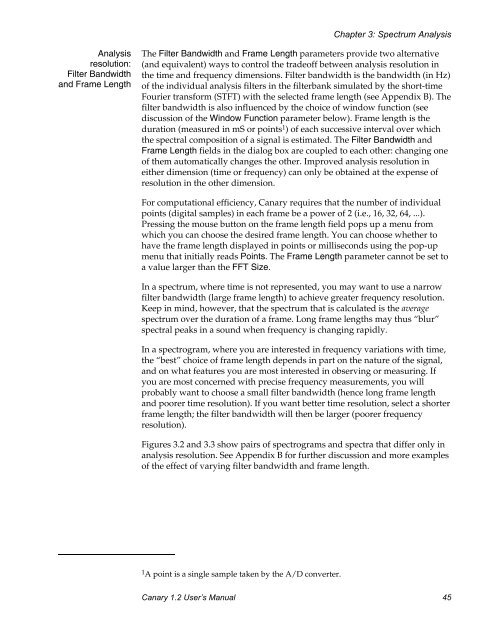User's Manual - Cornell Lab of Ornithology - Cornell University
User's Manual - Cornell Lab of Ornithology - Cornell University
User's Manual - Cornell Lab of Ornithology - Cornell University
Create successful ePaper yourself
Turn your PDF publications into a flip-book with our unique Google optimized e-Paper software.
Chapter 3: Spectrum AnalysisAnalysisresolution:Filter Bandwidthand Frame LengthThe Filter Bandwidth and Frame Length parameters provide two alternative(and equivalent) ways to control the trade<strong>of</strong>f between analysis resolution inthe time and frequency dimensions. Filter bandwidth is the bandwidth (in Hz)<strong>of</strong> the individual analysis filters in the filterbank simulated by the short-timeFourier transform (STFT) with the selected frame length (see Appendix B). Thefilter bandwidth is also influenced by the choice <strong>of</strong> window function (seediscussion <strong>of</strong> the Window Function parameter below). Frame length is theduration (measured in mS or points 1 ) <strong>of</strong> each successive interval over whichthe spectral composition <strong>of</strong> a signal is estimated. The Filter Bandwidth andFrame Length fields in the dialog box are coupled to each other: changing one<strong>of</strong> them automatically changes the other. Improved analysis resolution ineither dimension (time or frequency) can only be obtained at the expense <strong>of</strong>resolution in the other dimension.For computational efficiency, Canary requires that the number <strong>of</strong> individualpoints (digital samples) in each frame be a power <strong>of</strong> 2 (i.e., 16, 32, 64, ...).Pressing the mouse button on the frame length field pops up a menu fromwhich you can choose the desired frame length. You can choose whether tohave the frame length displayed in points or milliseconds using the pop-upmenu that initially reads Points. The Frame Length parameter cannot be set toa value larger than the FFT Size.In a spectrum, where time is not represented, you may want to use a narrowfilter bandwidth (large frame length) to achieve greater frequency resolution.Keep in mind, however, that the spectrum that is calculated is the averagespectrum over the duration <strong>of</strong> a frame. Long frame lengths may thus “blur”spectral peaks in a sound when frequency is changing rapidly.In a spectrogram, where you are interested in frequency variations with time,the “best” choice <strong>of</strong> frame length depends in part on the nature <strong>of</strong> the signal,and on what features you are most interested in observing or measuring. Ifyou are most concerned with precise frequency measurements, you willprobably want to choose a small filter bandwidth (hence long frame lengthand poorer time resolution). If you want better time resolution, select a shorterframe length; the filter bandwidth will then be larger (poorer frequencyresolution).Figures 3.2 and 3.3 show pairs <strong>of</strong> spectrograms and spectra that differ only inanalysis resolution. See Appendix B for further discussion and more examples<strong>of</strong> the effect <strong>of</strong> varying filter bandwidth and frame length.1 A point is a single sample taken by the A/D converter.Canary 1.2 User’s <strong>Manual</strong> 45
















